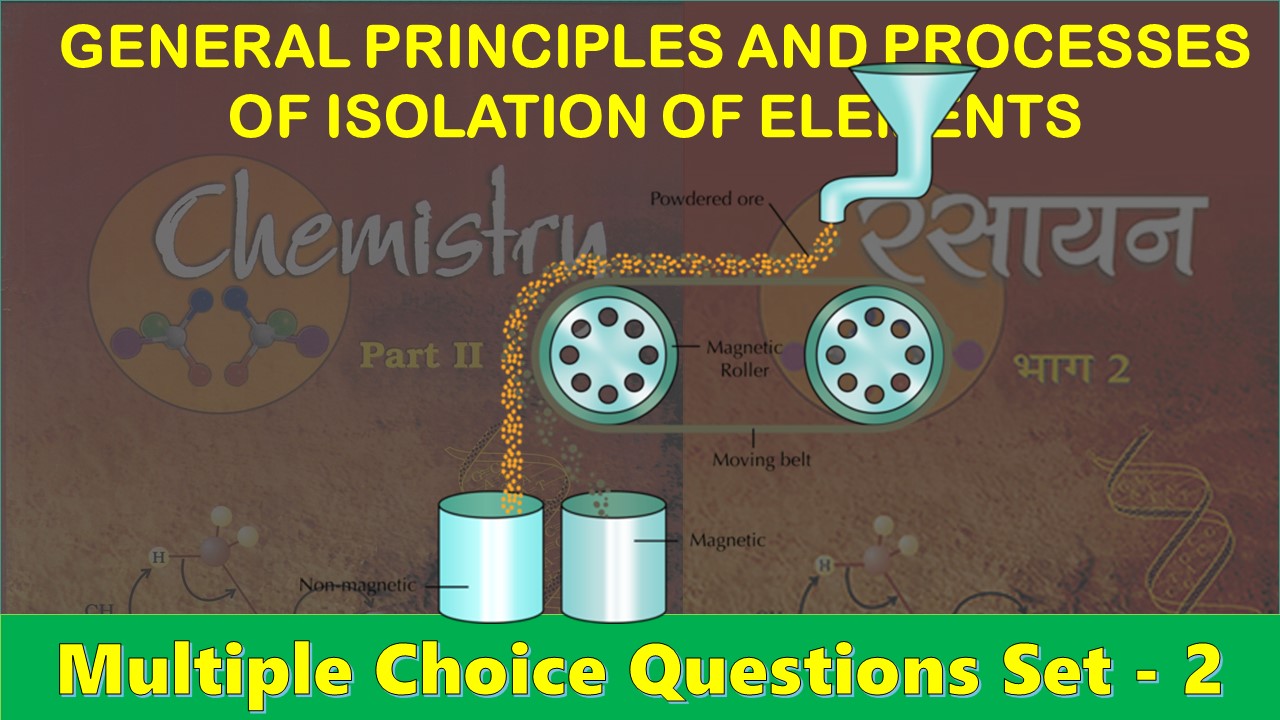CBSE Class 12 General Principles and Processes of Isolation of Elements Multiple Choice Questions with Answers. MCQ Questions Class 12 General Principles and Processes of Isolation of Elements with Answers Is Prepared Based on Latest Exam Pattern. Students can solve NCERT Class 12 General Principles and Processes of Isolation of Elements MCQs with Answers to know their preparation level.
Students who are searching for NCERT MCQ Questions for Class 12 General Principles and Processes of Isolation of Elements with Answers are compiled here to get good practice on all fundamentals. Know your preparation level on MCQ Questions for Class 12 General Principles and Processes of Isolation of Elements with Answers. You can also verify your answers from our provided MCQ Class 12 General Principles and Processes of Isolation of Elements with Answers. So, ace up your preparation with MCQ of Class 12 Chemistry Examinations.
MCQ Questions Class 12 General Principles and Processes of Isolation of Elements with Answers - Set - 2
Question 1:
Which of the following pairs of metals is purified by van Arkel method?
(a) Ga and In
(b) Zr and Ti
(c) Ag and Au
(d) Ni and Fe
Correct Answer – (B)
Question 2 :
Extraction of gold and silver involves leaching with
CN– ion. Silver is later recovered by
(a) distillation
(b) zone refining
(c) displacement with Zn
(d) liquation
Correct Answer – (C)
Question 3 :
Purification of aluminium, by electrolytic refining, is known as
(a) Hoope’s process
(b) Baeyer’s process
(c) Hall’s process
(d) Serpeck’s process.
Correct Answer – (A)
Question 4 :
Nitriding is the process of surface hardening of steel by treating it in an atmosphere of
(a) NH3
(b) O3
(c) N2
(d) H2S
Correct Answer – (A)
Question 5 :
The following reactions take place in the blast furnace in the preparation of impure iron. Identify the reaction pertaining to the formation of the slag.
(a) Fe2O3(s) + 3CO(g) → 2Fe(l) + 3CO2(g)
(b) CaCO3(s) → CaO(s) + CO2(g)
(c) CaO(s) + SiO2(s) → CaSiO3(s)
(d) 2C(s) + O2(g) → 2CO(g)
Correct Answer – (C)
MCQ Questions Class 12 General Principles and Processes of Isolation of Elements with Answers
Question 6:
Identify the correct statement from the following :
(a) Wrought iron is impure iron with 4% carbon.
(b) Blister copper has blistered appearance due to evolution of CO2.
(c) Vapour phase refining is carried out for Nickel by van Arkel method.
(d) Pig iron can be moulded into a variety of shapes.
Correct Answer – (D)
Question 7:
Calcium is obtained by
(a) reduction of calcium chloride with carbon
(b) electrolysis of molten anhydrous calcium chloride
(c) roasting of limestone
(d) electrolysis of solution of calcium chloride in H2O.
Correct Answer – (B)
Question 8:
Aluminium is extracted from alumina (Al2O3) by electrolysis of a molten mixture of
(a) Al2O3 + HF + NaAlF4
(b) Al2O3 + CaF2 + NaAlF4
(c) Al2O3 + Na3AlF6 + CaF2
(d) Al2O3 + KF + Na3AlF6
Correct Answer – (C)
Question 9:
Which of the following statements, about the advantage of roasting of sulphide ore before reduction is not true?
(a) The DGf° of the sulphide is greater than those for CS2 and H2S.
(b) The DGf° is negative for roasting of sulphide ore to oxide.
(c) Roasting of the sulphide to the oxide is thermodynamically feasible.
(d) Carbon and hydrogen are suitable reducing agents for metal sulphides.
Correct Answer – (D)
Question 10:
Which of the following elements is present as the impurity to the maximum extent in the pig iron?
(a) Manganese
(b) Carbon
(c) Silicon
(d) Phosphorus
Correct Answer – (B)
- NCERT Solutions Class 11 Chemistry Chapter 1 : Some Basic Concepts of Chemistry
- NCERT Solutions Class 11 Chemistry Chapter 2 : Structure Of The Atom
- NCERT Solutions Class 11 Chemistry Chapter 3 : Classification of Elements and Periodicity in Properties
- NCERT Solutions Class 11 Chemistry Chapter 4 : Chemical Bonding and Molecular Structure
- NCERT Solutions Class 11 Chemistry Chapter 5 : States of Matter
- NCERT Solutions Class 11 Chemistry Chapter 6 : Thermodynamics
- NCERT Solutions Class 11 Chemistry Chapter 7 : Equilibrium
- NCERT Solutions Class 11 Chemistry Chapter 8 : Redox Reactions
- NCERT Solutions Class 11 Chemistry Chapter 9 : Hydrogen
- NCERT Solutions Class 11 Chemistry Chapter 10 : The s-Block Elements
- NCERT Solutions Class 11 Chemistry Chapter 11 : The p-Block Elements
- NCERT Solutions Class 11 Chemistry Chapter 12 : Organic Chemistry: Some Basic Principles and Techniques
- NCERT Solutions Class 11 Chemistry Chapter 13 : Hydrocarbons
- NCERT Solutions Class 11 Chemistry Chapter 14 : Environmental Chemistry



